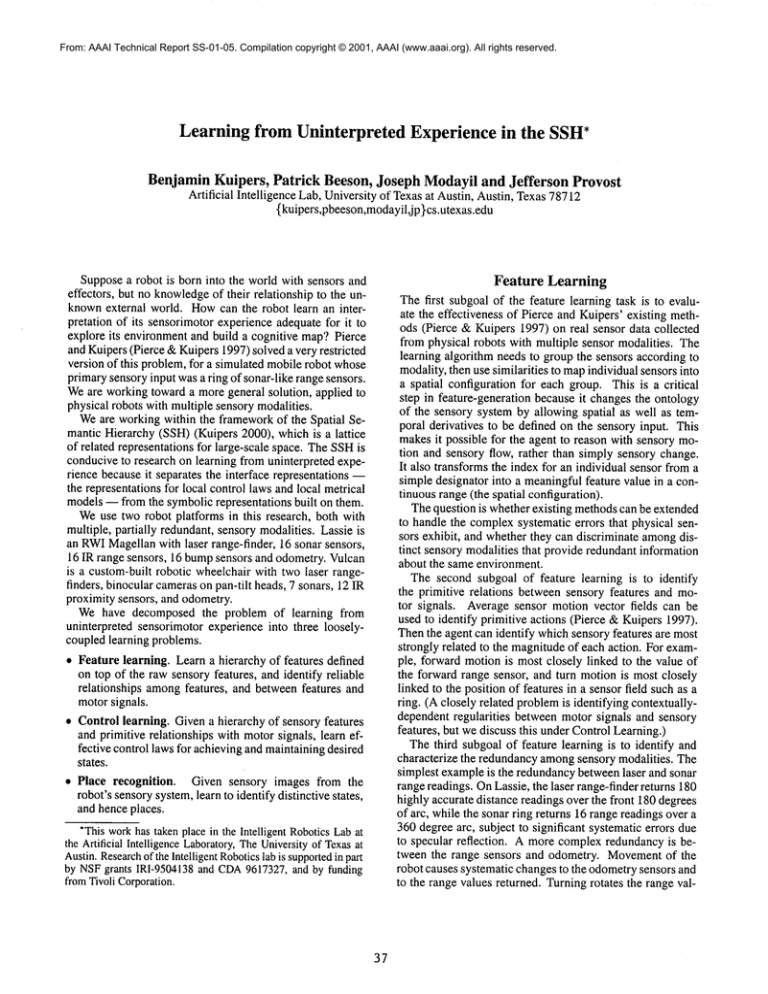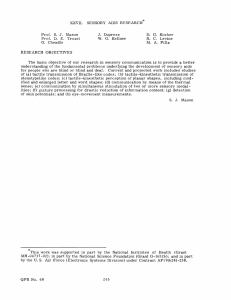
From: AAAI Technical Report SS-01-05. Compilation copyright © 2001, AAAI (www.aaai.org). All rights reserved.
Learning from Uninterpreted Experience in the SSH*
Benjamin Kuipers, Patrick Beeson, Joseph ModayU and Jefferson
Provost
Artificial Intelligence Lab, University of Texasat Austin, Austin, Texas78712
{kuipers,pbeeson,modayiljp}cs.utexas.edu
Supposea robot is born into the world with sensors and
effectors, but no knowledgeof their relationship to the unknownexternal world. Howcan the robot learn an interpretation of its sensorimotor experience adequate for it to
explore its environment and build a cognitive map?Pierce
and Kuipers (Pierce &Kuipers 1997) solved a very restricted
version of this problem,for a simulated mobilerobot whose
primarysensory input was a ring of sonar-like range sensors.
Weare working toward a moregeneral solution, applied to
physical robots with multiple sensory modalities.
Weare working within the frameworkof the Spatial Semantic Hierarchy (SSH)(Kuipers 2000), which is a lattice
of related representations for large-scale space. TheSSHis
conduciveto research on learning from uninterpreted experience becauseit separates the interface representations -the representations for local control laws and local metrical
models-- from the symbolic representations built on them.
Weuse two robot platforms in this research, both with
multiple, partially redundant, sensory modalities. Lassie is
an RWIMagellanwith laser range-finder, 16 sonar sensors,
16 IR range sensors, 16 bumpsensors and odometry. Vulcan
is a custom-built robotic wheelchair with two laser rangefinders, binocular camerason pan-tilt heads, 7 sonars, 12 IR
proximity sensors, and odometry.
Wehave decomposed the problem of learning from
uninterpreted sensorimotor experience into three looselycoupled learning problems.
¯ Featurelearning. Learn a hierarchy of features defined
on top of the raw sensory features, and identify reliable
relationships amongfeatures, and between features and
motorsignals.
¯ Control learning. Given a hierarchy of sensory features
and primitive relationships with motorsignals, learn effective control laws for achievingand maintainingdesired
states.
¯ Place recognition. Given sensory images from the
robot’s sensorysystem,learn to identify distinctive stateS,
and hence places.
*Thisworkhas taken place in the Intelligent RoboticsLabat
the Artificial IntelligenceLaboratory,TheUniversityof Texasat
Austin.Research
of the IntelligentRoboticslab is supported
in part
by NSFgrants IRI-9504138and CDA9617327, and by funding
fromTivoli Corporation.
37
Feature Learning
The first subgoal of the feature learning task is to evaluate the effectiveness of Pierce and Kuipers’ existing methods (Pierce & Kuipers 1997) on real sensor data collected
from physical robots with multiple sensor modalities. The
learning algorithm needs to group the sensors according to
modality,then use similarities to mapindividual sensors into
a spatial configuration for each group. This is a critical
step in feature-generation because it changes the ontology
of the sensory system by allowing spatial as well as temporal derivatives to be defined on the sensory input. This
makesit possible for the agent to reason with sensory motion and sensory flow, rather than simply sensory change.
It also transforms the index for an individual sensor from a
simple designator into a meaningfulfeature value in a continuous range (the spatial configuration).
The question is whetherexisting methodscan be extended
to handle the complexsystematic errors that physical sensors exhibit, and whether they can discriminate amongdistinct sensory modalities that provide redundant information
about the same environment.
The second subgoal of feature learning is to identify
the primitive relations between sensory features and motor signals. Average sensor motion vector fields can be
used to identify primitive actions (Pierce &Kuipers 1997).
Thenthe agent can identify whichsensory features are most
strongly related to the magnitudeof each action. For example, forward motion is most closely linked to the value of
the forward range sensor, and turn motion is most closely
linked to the position of features in a sensor field such as a
ring. (A closely related problemis identifying contextuallydependent regularities between motor signals and sensory
features, but we discuss this under Control Learning.)
The third subgoal of feature learning is to identify and
characterize the redundancyamongsensory modalities. The
simplest exampleis the redundancybetweenlaser and sonar
range readings. OnLassie, the laser range-finder returns 180
highly accurate distance readings over the front 180 degrees
of arc, while the sonar ring returns 16 range readings over a
360 degree arc, subject to significant systematic errors due
to specular reflection. A more complexredundancy is between the range sensors and odometry. Movementof the
robot causes systematic changesto the odometrysensors and
to the range values returned. Turningrotates the range val-
2,
put. Weare experimenting with ways to optimize nonlin
ear shapes for these functional relationships using reinforcement from overall task performance.
ues returned amongthe sensors in each modality. Travel has
direct effect on forward and rear range sensors, but less or
no effect on lateral range sensors. Yet another redundancyis
the relation betweenrange sensors and bumpsensors. When
travel reduces the forwardrange sensor to a certain value, a
correspondingbumpsensor is likely to signal.
One issue is howto represent the individual redundancies as they are discovered. A deeper issue is whetherit is
possible to makethe abductive transition from an egocentric modelof sensor input to an allocentric (world-centered)
modelof obstacles with locations in a fixed frame of reference, in whichrobot actions changethe robot’s position.
This transition supports the local metrical mapportion of
the SSHControl Level. It is not absolutely necessary for
exploration, since the ability to execute control laws can be
achieved egocentrically without knowledgeof local geometry, and can support the SSHCausal and Topological levels.
However,if it can be achieved, it accountsfor the origin of
local fixed framesof reference, whichare the foundationfor
local metrical maps, then the patchworkmap,and finally the
global metrical map.
Place Recognition
Oncethe control laws are functioning as desired, the robot
can move reliably from one distinctive state to others
throughout the environment. At each of these distinctive
states, the robot’s sensory systemprovides a sensory image.
There will be a significant amountof variation in the images
obtained at a given distinctive state, due to a numberof factors includingvariation in the precise position the robot is in
whenthe hill-climbing control law terminates, differences
in clutter or transient pedestrians, or evenillumination differences due to different times of the day or seasons of the
year.
Becauseof this variation, it is essential to cluster images,
so the imagesassociated with the samedistinctive state fall
into the same cluster, which we call a view. The clustering can be done with an unsupervised learning method, for
example Self-Organizing Maps (SOMs)(Kohonen 1995).
Unfortunately, different distinctive states maywell have
the sameview, leading to sensory aliasing. That is, the current view maynot be sufficient to determinethe current distinctive state. (This problemcan never be completelysolved,
since two distinctive states mayhave identical physical surroundings.)
There are a variety of methodsfor using contextual information to identify the current distinctive state from its
connectivity with other distinctive states in the environment
(Kuipers & Byun1991). If this is successful, we can use
supervised learning methodsuch as a backpropagation network to learn the mappingdirectly from images to distinctive states. Wehypothesizethat the hiddenunits in the backprop networkwill learn features of the image that might be
too subtle, or too dominatedby noise, to be usable for clustering by an unsupervised learner, but which can be identified with the additional feedback provided by the correct
identity of the distinctive state.
If successful, this methodresults in the ability to recognize the current distinctive state from the current sensory
image, focusing on the features that provide useful information and ignoring larger amountsof sensory noise. Weare
in the midst of testing this methodusing laser range-finder
data, and we hopeto extend it to visual sensor input.
Control Learning
Onceconnections have been learned between motor signals
and certain sensory feature values, the goal of control learning is to construct the control laws that makeup the SSH
Control level, and thus support the rest of the cognitive map.
Weneed to learn control laws for hill-climbing to locally
distinctive states oncein a neighborhood,and to follow trajectories from one distinctive state to the neighborhoodof
the next.
Thefirst subgoalin control learning is to identify contexts
(states wherecertain features have certain values) in which
particular relationships between motor signal and feature
values are reliably observed. For example, if a local minimumrange value is directly ahead, then a travel action will
reliably decrease it, and if the local minimum
range value
is directly in a lateral position, then a travel action will tend
to leave it constant. This subgoalclearly interacts strongly
with the feature-learning part of the project. A particular
problemis that temporal derivatives are mostly likely to be
related to motorsignals, and they are notoriously noisy when
computedfrom real data.
The secondsubgoal is to composethese relationships into
control laws to (a) movea specified feature to a desired
value, (b) select a context in whichone feature value can
changedwhile leaving another feature value relatively unchanged, and (c) makeclosed-loop adjustments to keep one
feature close to a desired value while changingthe other.
The approach to defining control laws in (Pierce
Kuipers1997, sect. 5) uses proportional-integral control law
templates that encode a significant amountof background
knowledgefrom control engineering. The third subgoal of
this task is to approach the control learning problemusing methodsfrom reinforcement learning to achieve better results while presupposing smaller and more plausible
amounts of background knowledge.
A control law typically includes several functional relationships between sensory features and the motor out-
References
Kohonen, T. 1995. Self-Organizing Maps. Berlin; New
York: Springer.
Kuipers, B. J., and Byun, Y.-T. 1991. A robot exploration
and mappingstrategy based on a semantic hierarchy of spatial representations. Journal of Robotics and Autonomous
Systems 8:47-63.
Kuipers, B. J. 2000. The spatial semantic hierarchy. Artificial Intelligence 119:191-233.
Pierce, D. M., and Kuipers, B. J. 1997. Maplearning with
uninterpreted sensors and effectors. Artificial Intelligence
92:169-227.
38







